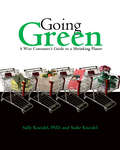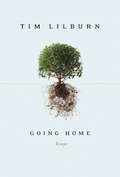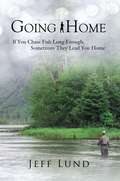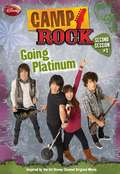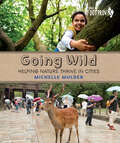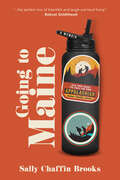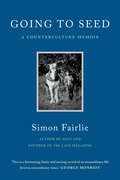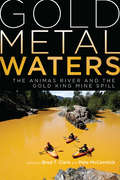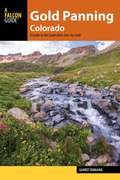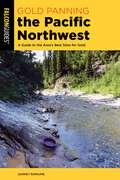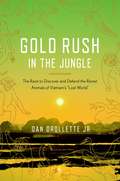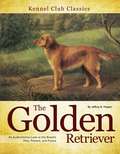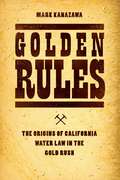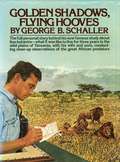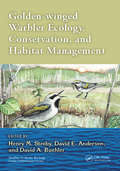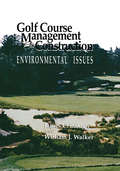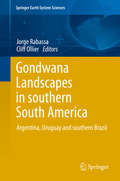- Table View
- List View
Going Global: Protecting the Environment
by Marcia Amidon LustedSometimes, preservation and conservation need to occur on a larger scale. Oceana, Greenpeace, and the World Wildlife Fund are dedicated to protecting resources all over the world—especially resources that all people share.
Going Green
by Sally Kneidel Sadie KneidelGoing Green focuses on the biggest environmental culprits of the American lifestyle--diet, housing, clothing, and transportation--and provides practical, effective steps we can take to reduce our carbon footprint and live more sustainably. Comprehensive and empowering, it will make you think twice about every dollar you spend.
Going Home: Essays
by Tim LilburnLike his contemporaries Robert Bringhurst, Ronald Wright, Dennis Lee, Don McKay, and Jan Zwicky, Tim Lilburn has long been a deep thinker on issues of ecology and writing, and on how the two fit together philosophically, morally, and ethically. In Going Home, Lilburn addresses how we relate (often uneasily) to our physical landscape in Canada and the United States.Retrieving an almost lost strand in the Western intellectual tradition -- the erotic, contemplative strand, from Plato to John Cassian to the Areopagite -- Lilburn traces a history of eros and desire in the hope that this exercise and its awakening can lead us home to a full residence in North America. Surprising and enlightening, the collection finishes with two unforgettable personal essays, where Lilburn writes about his effort to enact desire in the place where his ancestors are buried, the flatlands and coulees of southern Saskatchewan.
Going Home: If you chase fish long enough, sometimes they lead you home
by Jeff LundIt doesn't matter if you're in the woods every other weekend or every other day. Outdoorsman or angler are broad terms and applies to a large population. However, the title does not encapsulate someone who frequently engages in either. Ultimately, anglers, hunters, hikers, etc., are ordinary people whose lives move from anecdote to anecdote, until life gets serious. An outdoorsman is not immune to failure, complex life decisions, nor are things simpler. Being on the water with a fly rod or in the alpine with a rifle does not provide answers because neither a mountain or a fish can talk. However, when life brings trauma, a fly rod can be the best weapon with which to keep fighting. Going Home is a memoir about fishing, without being just about fishing. It's about a man contemplating direction and his sense of home after he is jerked from his linear journey of a life spent chasing fish.
Going Platinum (Camp Rock #3)
by Helen PerelmanMitchie thinks having her mom around as camp cook is tough. But when Tess´s mother arrives as a guest counselor, Mitchie realizes her drama is low-key in comparison. T.J. Tyler is a diva with a capital D! Can Camp Rock handle two Tylers in the spotlight?
Going Wild: Helping Nature Thrive in Cities (Orca Footprints #12)
by Michelle MulderWhat if the new key to making our lives safer (and even healthier) is to allow the wilderness back into our cities? Going wild. We don't see it as a good thing. And why would we? For most of our time on earth, humanity has been running from lions and other wilderness dangers. We've worked hard to make our local landscapes as safe and convenient as possible. Sometimes that's meant paving over areas that might burst into weeds. Other times, we've dammed rivers for electricity or irrigation. But now pollution, climate change and disruptions to the water cycle are affecting the world in ways we never anticipated. The epub edition of this title is fully accessible.
Going for the Rain: Poems
by Simon J. OrtizA member of the Acoma Pueblo in Arizona, Ortiz's poems evoke love and family and ceremony, the strains of disenfranchisement and the beautiful dry land.
Going to Maine: All the Ways to Fall on the Appalachian Trail
by Sally Chaffin BrooksFrom comedian Sally Chaffin Brooks comes a memoir about the thing she can't seem to shut up about— her life changing thru-hike of the Appalachian Trail. 25-year-old Sally has no reason to upend her comfortable, conventional life to spend 5 months hiking the Appalachian Trail; no reason except that her charismatic best friend, Erin, asked her to come along. A woefully out-of-shape Sally quickly realizes she may not actually be prepared for the realities of thru-hiking— brutal weather, wrong turns, and painful blisters have her wanting to quit almost as soon as she starts. But out of loyalty to Erin, or maybe the sinking realization that her life needed upending, Sally sticks it out. As she and Erin trek from Georgia to Maine, they collect a ragtag band of hikers and together stumble from one hilarious (and sometimes scary) predicament to another. By the time she reaches Maine— accompanied by Erin, their crew, and a guy she's maybe (definitely) falling in love with— readers will cheer for the stronger, more self-assured Sally that has emerged and wish they could start the laugh-out-loud, life-affirming adventure all over again.
Going to Seed: A Counterculture Memoir
by Simon FairlieAn unforgettable firsthand account of how the hippie movement flowered in the late 1960s, appeared spent by the Thatcher-consumed 1980s, yet became the seedbed for progressive reform we now take for granted—and continues to inspire generations of rebels and visionaries. "Fairlie has a refreshingly declarative style: he’s analytical, funny and self-aware. . . His memoir has much to offer anyone interested in movement history or in the future of intentional communities."—Elizabeth Royte, Food & Environment Reporting Network At a young age, Simon Fairlie rejected the rat race and embarked on a new trip to find his own path. He dropped out of Cambridge University to hitchhike to Istanbul and bicycle through India. He established a commune in France, was arrested multiple times for squatting and civil disobedience, and became a leading figure in protests against the British government’s road building programs of the 1980s and—later—in legislative battles to help people secure access to land for low impact, sustainable living. Over the course of fifty years, we witness a man’s drive for self-sufficiency, freedom, authenticity, and a deep connection to the land. Fairlie grew up in a middle-class household in leafy middle England. His path had been laid out for him by his father: boarding school, Oxbridge, and a career in journalism. But everything changed when Simon’s life ran headfirst into London’s counterculture in the 1960s. Finding Beat poetry, blues music, cannabis and anti–Vietnam War protests unlocked a powerful lust to be free. Instead of becoming a celebrated Fleet Street journalist like his father, Simon became a laborer, a stonemason, a farmer, a scythesman, and then a magazine editor and a writer of a very different sort. In Going to Seed he shares the highs of his experience, alongside the painful costs of his ongoing search for freedom—estrangement from his family, financial insecurity, and the loss of friends and lovers to the excesses and turbulence that continued through the 70s and 80s. Part moving, free-wheeling memoir, part social critique, Going to Seed questions the current trajectory of Western “progress”—and the explosive consumerism, growing inequality, and environmental devastation laid bare in our daily newsfeeds—and will resonate with anyone who wonders how we got to such a place. Simon’s story is for anyone who wonders what the world might look like if we began to chart a radically different course.
Going to Seed: A Counterculture Memoir
by Simon Fairlie"Simon Fairlie is possibly the most influential—and unusual—eco-activist you might not have heard of."—The ObserverAn unforgettable firsthand account of how the hippie movement flowered in the late 1960s, appeared spent by the Thatcher-consumed 1980s, yet became the seedbed for progressive reform we now take for granted—and continues to inspire generations of rebels and visionaries."Fairlie has a refreshingly declarative style: he&’s analytical, funny and self-aware. . . His memoir has much to offer anyone interested in movement history or in the future of intentional communities."—Elizabeth Royte, Food & Environment Reporting NetworkAt a young age, Simon Fairlie rejected the rat race and embarked on a new trip to find his own path. He dropped out of Cambridge University to hitchhike to Istanbul and bicycle through India. He established a commune in France, was arrested multiple times for squatting and civil disobedience, and became a leading figure in protests against the British government&’s road building programs of the 1980s and—later—in legislative battles to help people secure access to land for low impact, sustainable living.Over the course of fifty years, we witness a man&’s drive for self-sufficiency, freedom, authenticity, and a deep connection to the land.Fairlie grew up in a middle-class household in leafy middle England. His path had been laid out for him by his father: boarding school, Oxbridge, and a career in journalism. But everything changed when Simon&’s life ran headfirst into London&’s counterculture in the 1960s. Finding Beat poetry, blues music, cannabis and anti–Vietnam War protests unlocked a powerful lust to be free. Instead of becoming a celebrated Fleet Street journalist like his father, Simon became a laborer, a stonemason, a farmer, a scythesman, and then a magazine editor and a writer of a very different sort. In Going to Seed he shares the highs of his experience, alongside the painful costs of his ongoing search for freedom—estrangement from his family, financial insecurity, and the loss of friends and lovers to the excesses and turbulence that continued through the 70s and 80s.Part moving, free-wheeling memoir, part social critique, Going to Seed questions the current trajectory of Western &“progress&”—and the explosive consumerism, growing inequality, and environmental devastation laid bare in our daily newsfeeds—and will resonate with anyone who wonders what the world might look like if we began to chart a radically different course."This is a fascinating, funny and moving record of an extraordinary life lived in extraordinary times."—George Monbiot
Gold Metal Waters: The Animas River and the Gold King Mine Spill
by Brad T. Clark Pete McCormickGold Metal Waters presents a uniquely inter- and transdisciplinary examination into the August 2015 Gold King Mine spill in Silverton, Colorado, when more than three million gallons of subterranean mine water, carrying 880,000 pounds of heavy metals, spilled into a tributary of the Animas River. The book illuminates the ongoing ecological, economic, political, social, and cultural significance of a regional event with far-reaching implications, showing how this natural and technical disaster has affected and continues to affect local and national communities, including Native American reservations, as well as agriculture and wildlife in the region. This singular event is surveyed and interpreted from multiple diverse perspectives—college professors, students, and scientists and activists from a range of academic and epistemological backgrounds—with each chapter reflecting unique professional and personal experiences. Contributors examine both the context for this event and responses to it, embedding this discussion within the broader context of the tens of thousands of mines leaking pollutants into waterways and soils throughout Colorado and the failure to adequately mitigate the larger ongoing crisis. The Gold King Mine spill was the catalyst that finally brought Superfund listing to the Silverton area; it was a truly sensational event in many respects. Gold Metal Waters will be of interest to students and scholars in all disciplines, but especially in environmental history, western history, mining history, politics, and communication, as well as general readers concerned with human relationships with the environment. Contributors: Alane Brown, Brian L. Burke, Karletta Chief, Steven Chischilly, Becky Clausen, Michael A. Dichio, Betty Carter Dorr, Cynthia Dott, Gary Gianniny, David Gonzales, Andrew Gulliford, Lisa Marie Jacobs, Ashley Merchant, Teresa Montoya, Scott W. Roberts, Lorraine L. Taylor, Jack Turner, Keith D. Winchester, Megan C. Wrona, Janene Yazzie
Gold Panning California: A Guide to the Area's Best Sites for Gold (Gold Panning)
by Garret RomaineGold Panning California is the premiere reference source for anyone who is interested in getting started or continuing their gold prospecting in California. Containing accurate, up-to-date prospecting information for all known panning areas in California. The write-ups for each locale include driving directions, GPS coordinates, historical information, land ownership restrictions, full-color photos, and geological background.Features include:Full-color imagesGPS coordinatesGeology basicsTools of the trade for every level of collectorRules and regulationsPolishing, preserving, crafting, and displaying your treasures
Gold Panning Colorado: A Guide to the State's Best Sites for Gold (Gold Panning)
by Garret RomaineGold Panning Colorado is the premiere reference source for anyone who is interested in getting started or continuing their gold prospecting in Colorado. Containing accurate, up-to-date prospecting information for all known panning areas in Colorado. The write-ups for each locale include driving directions, GPS coordinates, historical information, land ownership restrictions, full-color photos, and geological background.Features include:Full-color imagesGPS coordinatesGeology basicsTools of the trade for every level of collectorRules and regulationsPolishing, preserving, crafting, and displaying your treasures
Gold Panning the Pacific Northwest: A Guide to the Area's Best Sites for Gold (Gold Panning)
by Garret RomaineGold Panning the Pacific Northwest is the premiere reference source for anyone who is interested in getting started or continuing their gold prospecting in the pacific northwest region. Containing accurate, up-to-date prospecting information for all known panning areas in Oregon, Washington, and Idaho. The write-ups for each locale include driving directions, GPS coordinates, historical information, land ownership restrictions, full-color photos, and geological background.Features include:Full-color imagesGPS coordinatesGeology basicsTools of the trade for every level of collectorRules and regulationsPolishing, preserving, crafting, and displaying your treasures
Gold Panning the Pacific Northwest: A Guide to the Area's Best Sites for Gold (Gold Panning)
by Garret RomaineGold Panning the Pacific Northwest is the premiere reference source for anyone who is interested in getting started or continuing their gold prospecting in the pacific northwest region. Fully revised and updated, this guide contains accurate, up-to-date prospecting information for all known panning areas in Oregon, Washington, and Idaho. The write-ups for each locale include driving directions, GPS coordinates, historical information, land ownership restrictions, full-color photos, and geological background.Features include:Full-color imagesGPS coordinatesGeology basicsTools of the trade for every level of collectorRules and regulationsPolishing, preserving, crafting, and displaying your treasures
Gold Rush in the Jungle: The Race to Discover and Defend the Rarest Animals of Vietnam's "Lost World"
by Dan DrolletteAn engrossing, adventure-filled account of the rush to discover and save Vietnam's most extraordinary animals Deep in the jungle where the borders of Vietnam meet those of Laos and Cambodia is a region known as "the lost world." Large mammals never seen before by Western science have popped up frequently in these mountains in the last decade, including a half-goat/half-ox, a deer that barks, and a close relative of the nearly extinct Javan rhino. In an age when scientists are excited by discovering a new kind of tube worm, the thought of finding and naming a new large terrestrial mammal is astonishing, and wildlife biologists from all over the world are flocking to this dangerous region. The result is a race between preservation and destruction. Containing research gathered from famous biologists, conservationists, indigenous peoples, former POWs, ex-Viet Cong, and the first U.S. ambassador to Vietnam since the war's end, Gold Rush in the Jungle goes deep into the valleys, hills, and hollows of Vietnam to explore the research, the international trade in endangered species, the lingering effects of Agent Orange, and the effort of a handful of biologists to save the world's rarest animals.
Golden Bats and Pink Pigeons: A Journey to the Flora and Fauna of a Unique Island (El\libro De Bolsillo Ser.)
by Gerald DurrellTravel to Mauritius on a quest to save endangered species with the British naturalist whose work inspired Masterpiece production The Durrells in Corfu. The green and mountainous island of Mauritius in the Indian Ocean was once the home of the ill-fated dodo. The island saw many other animals vanish from its soil, and by the 1970s, numerous species were close to being eliminated. Enter Gerald Durrell. Durrell sets out on a search for bats and pink pigeons, climbing near-vertical rock faces to find Telfair&’s skinks and Gunther&’s geckos, and swimming about coral reefs with multicolored marine life. But rounding up a collection to take back with him to his animal sanctuary in the English Channel won&’t be easy: There are many dangers awaiting him. Golden Bats and Pink Pigeons is a delightful and inspiring adventure by the author of My Family and Other Animals, among other much-loved memoirs. This ebook features an illustrated biography of Gerald Durrell including rare photos from the author&’s estate.
Golden Retriever
by Jeffrey G. PepperFourth in the Kennel Club Books' Classics series, The Golden Retriever recognizes the ever-popular all-American breed in this one spectacular volume. Written by author, breeder, and judge, Jeffrey G. Pepper, this book's engaging chapters on everything from the breed's accomplishments in performance events, to their participation as service dogs make it much more than just "another breed book." With more than 100 vintage and modern photographs of the breed, this book is a must-have for every Golden owner.
Golden Retrievers and Other Sporting Dogs (World Book's Animals of the World)
by Robert Blackburn KnightIntroduces the Golden Retriever dog breed and talks about other sporting dogs, in a question and answer format.
Golden Rules: The Origins of California Water Law in the Gold Rush
by Mark KanazawaFresh water has become scarce and will become even more so in the coming years, as continued population growth places ever greater demands on the supply of fresh water. At the same time, options for increasing that supply look to be ever more limited. No longer can we rely on technological solutions to meet growing demand. What we need is better management of the available water supply to ensure it goes further toward meeting basic human needs. But better management requires that we both understand the history underlying our current water regulation regime and think seriously about what changes to the law could be beneficial. For Golden Rules, Mark Kanazawa draws on previously untapped historical sources to trace the emergence of the current framework for resolving water-rights issues to California in the 1850s, when Gold Rush miners flooded the newly formed state. The need to circumscribe water use on private property in support of broader societal objectives brought to light a number of fundamental issues about how water rights ought to be defined and enforced through a system of laws. Many of these issues reverberate in today’s contentious debates about the relative merits of government and market regulation. By understanding how these laws developed across California’s mining camps and common-law courts, we can also gain a better sense of the challenges associated with adopting new property-rights regimes in the twenty-first century.
Golden Shadows, Flying Hooves: With A New Afterword
by George B. SchallerGeorge Schaller here shares with his reader the fascinating personal story behind his scientific discoveries that have so notably advanced our knowledge of the great African predators. In his new books, he allows us to participate moment by moment in his work and his experience on the Tanzanian plains as for three years he made his extraordinary of the habits, the hunting methods, the social systems, and the behavior—the lives from birth to death—of the lion, the wild dog, the cheetah, the leopard, and the hyena. We follow him afoot and in a Land-Rover, through the thickets, plains, and wooded grasslands of this wild, harsh landscape as he tranquilizes and then tags the great predators, as he gets to know their individual characteristics, as he investigates the vast array of species they depend upon for survival. We feel Schaller’s exaltation in the pure sensual motions of a lion stalking its prey, watch with him as a small furry mouse defends itself valiantly against a pack of wild dogs, as an Egyptian vulture breaks an ostrich eggs with a stone . . . We come to know the various postures of the animals in the hunt, what their territorial range is, how they behave with one another, how they raise their young . . . We are there as Schaller hangs a tiny radio transmitter around the neck of an old lion—the beeps will enable him to track the animal by night as well as day. We observe the businesslike gatherings of wild dogs, the blinding speed and elegant graces of a coursing cheetah, the soft-footed stalk of the hunting leopard, the tension that ripples though a herd id gazelle when they sense an approaching predator. We go back in times, through two million years, while Schaller and his colleagues attempt to simulate the hunting behavior of that pre-human, the hominid Australopithecus, scrabbling and scavenging for food, developing, in the process of their experiment, an incredible sensitivity to the sounds of zebra, giraffe, hyena, and the low, purposeful flight of a vulture—any sign of a possible meal, shelter, enemy. And, throughout, we feel Schaller’s commitment, his strong emotional kinship with the animals he studies and with the wild landscape where he and his family created a full life for themselves far from the accouterments of modern civilizations. With the gift of expressive narrative that distinguished his famous international bestseller, The Year of the Gorilla, Schaller makes us know close-up not only the teeming life of the plains and the great human adventure he lived but also the inspired improvisation, the tirelessness, the flights of imaginations that, as much as meticulous fact-finding, are an organic part of the original scientific investigation.
Golden-winged Warbler Ecology, Conservation, and Habitat Management (Studies in Avian Biology)
by Henry M. Streby, David E. Andersen and David A. BuehlerGolden-winged Warblers (Vermivora chrysoptera) are migratory songbirds that breed in temperate North America, primarily in the Great Lakes region with remnant populations throughout the Appalachian Mountains, and winter in Central and northern South America. Their breeding range has contracted dramatically in the Appalachian Mountains and many populations have dramatically declined, likely due to habitat loss, competition and interbreeding with Blue-winged Warblers (Vermivora pinus), andglobal climate change.. As a result of population declines in much of the eastern portion of their breeding range, Golden-winged Warblers are listed as endangered or threatened in 10 U.S. states and in Canada and have been petitioned for protection under the U.S. Endangered Species Act. Published in collaboration with and on behalf of The American Ornithological Society, this volume in the highly-regarded Studies in Avian Biology series compiles extensive, current research on Golden-winged Warblers and summarizes what is known and identifies many remaining unknowns, providing a wealth of peer-reviewed science on which future research and listing decisions can be based.
Golf Course Management & Construction: Environmental Issues
by James C. Balogh William J. WalkerGolf Course Management & Construction presents a comprehensive summary and assessment of technical and scientific research on the environmental effects of turfgrass system construction and maintenance. Although the book focuses on golf courses, it also discusses turfgrass systems for residential and commercial lawns, parks, and greenways. The book is an excellent introduction to the concepts of nonpoint source environmental impacts of turfgrass management for turfgrass scientists and specialists, landscape and golf course architects, turfgrass system and golf course developers, golf course superintendents, environmental scientists, and land-use regulators.
Goliath's Curse: The History and Future of Societal Collapse
by Luke KempA NEXT BIG IDEA CLUB'S MUST-READ BOOK • A radical retelling of human history through the cycle of societal collapse—"a Cassandra-like warning about the path today&’s oligarchs have set [and] a sweeping and dire vision of a world on the brink.&” (Publishers Weekly, starred review) &“Deeply sobering and strangely inspiring. . . . Read it now, or your descendants will find it in the ruins.&” —Johann Hari, author of Stolen Focus &“Anyone who doubts the importance of this conversation hasn&’t been paying attention.&” —Bill McKibben, author of Here Comes the Sun12,000 years ago, human history changed forever when the egalitarian groups of hunter-gathering humans began to settle down and organize themselves into hierarchies. The few dominated the many, seizing control through violence. What emerged were &“Goliaths&”: large societies built on a collection of hierarchies that are also terrifyingly fragile, collapsing time after time across the world. Today, we live in a single, global Goliath—one that is precariously interdependent—under threat from nuclear war, climate change, and the existential risks of AI. The next collapse may be our last. In Goliath&’s Curse, Cambridge scholar Luke Kemp conducts a historical autopsy on our species, from the earliest cities to the collapse of modern states like Somalia. Drawing on historical databases and the latest discoveries in archaeology and anthropology, he uncovers groundbreaking revelations: More democratic societies tend to be more resilient.A modern collapse is likely to be global, long-lasting, and more dire than ever before.Collapse may be invisible until after it has occurred. It&’s possible we&’re living through one now.Collapse has often had a more positive outcome for the general population than for the 1%.All Goliaths contain the seeds of their own demise. As useful for finding a way forward as it is for diagnosing our precarious present, Goliath&’s Curse is a stark reminder that there are both bright and dark sides to societal collapse—that it is not necessarily a reversion to chaos or a dark age—and that making a more resilient world may well mean making a more just one.
Gondwana Landscapes in southern South America
by Jorge Rabassa Cliff OllierThis book presents extensive and new information on the geomorphology of cratonic areas of southern South America. It includes valuable data relating to recurrent controversies in general geomorphology beyond the boundaries of South America and reveals the great need to integrate many different aspects of geomorphology in regional studies. With the focus on ancient landscapes and especially on planation surfaces it addresses the question of what processes could form such huge features, and how they can be preserved for so long. Many of the papers include maps of planation surfaces or other geomorphic units. The volume brings together an up-to-date, state-of-the-art collection of information on South American geomorphology, and shows beyond doubt that geomorphology is on the same time scale as global tectonics, biological evolution and major climate change. Some of the papers describe ancient geomorphological features of areas that have never been studied or published before, while others describe regions which are totally unknown to the public. The scope of the book extends from tropical latitudes north of the Tropic of Capricorn, south to freezing Patagonia in the "roaring fifties", more than 3,500 km from north to south. Including over one thousand citations from geological and geomorphological literature, this volume will serve as a starting point for a whole new phase of studies of the fascinating landscape history of southern South America.

